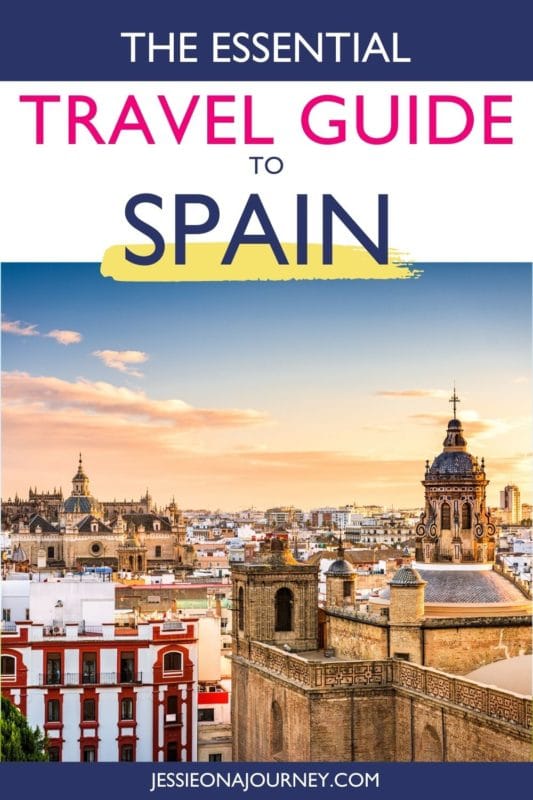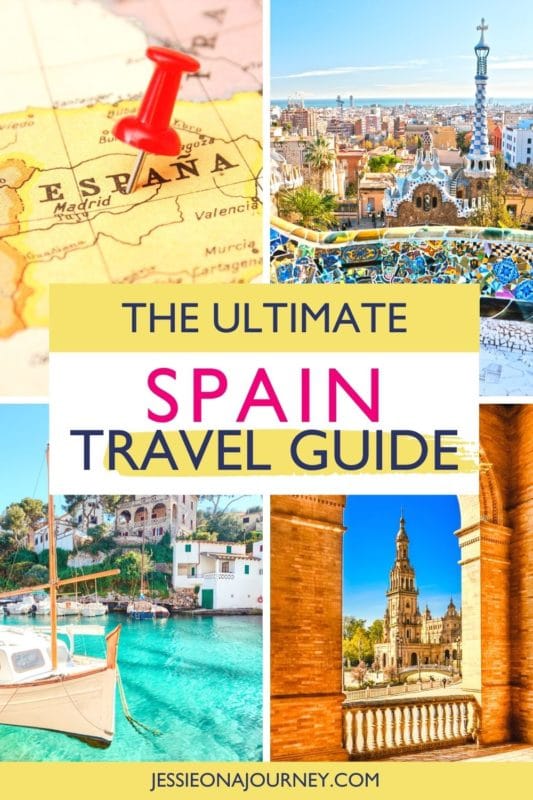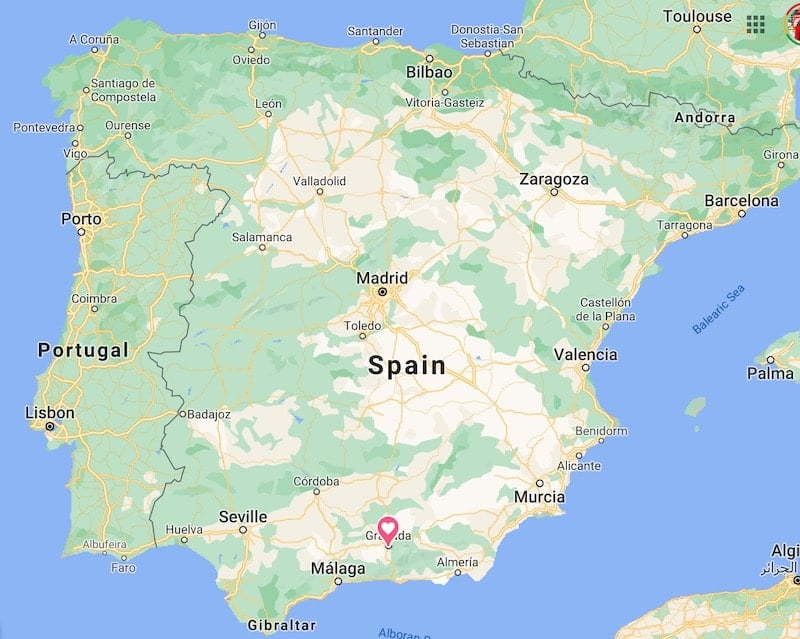Spain Travel Guide
Looking for an in-depth Spain travel guide?
Then you’re in the right place!
Spain is a bucket list destination for so many travelers around the world for its rich history, incredible sights, and gorgeous environment. In fact, it was ranked the second most visited country in the world by the United Nations World Tourism Organization, right behind neighboring France.
Once you start to research this country, it’s easy to see why it’s so popular. From adventurous hikers to art lovers to foodies, there’s something for everyone in Spain.
While Spain is full of great individual destinations like Barcelona, Madrid and Sevilla, Spain makes for an excellent road trip.
You can circle around the country, visiting cities from Zaragoza to Cordoba over the course of three to four weeks.
But if you’re time is limited, it might be easier to stick to one section of this vast nation.
Drive through northern Spain from Barcelona to the Basque Country to get a taste of the many unique cultures that make up Spain. Or travel through southern Spain and explore the medieval architecture of Andalucia and the Sierra Nevada mountains.
Not feeling a full road trip?
Plan some day trips out to the countryside around your main destination city! Your options are endless.
Spain is also so much more than the mainland on the Iberian Peninsula. The country also consists of two groups of islands:
The Balearic Islands in the Mediterranean and the Canary Islands off the coast of North Africa. Both offer some of the best beaches in the world and have cultures all their own.
The Balearic Islands are home to the notorious party island of Ibiza but if you’re not down to party until the sun comes up, you can enjoy the laid-back beaches of Formentera or the caves and waterfalls of Majorca.
The Canary Islands also offer active travel adventures in nature and gorgeous beaches where you can get some much-needed rest and relaxation.
Plus Spain’s relatively low crime rate makes it a great destination for solo female travel, both on the mainland and the islands.
Keep reading to dive into resources that will help you with planning a trip to Spain in Europe.
Note: This ultimate guide to Spain travel contains affiliate links to trusted partners!
- Spain Map
- Where To Go In Spain
- Granada Travel Guide
- Experiences In Spain
- Best Spain Tours
- Renting A Car In Spain
- Spain Train Travel
- Spain Hotels
- Spain Travel Insurance
- Spain Travel Guide FAQ
- Q: What do I need to know before traveling to Spain?
- Q: What are the best places to visit in Spain?
- Q: What is the best way to travel between cities in Spain?
- Q: Is Spain expensive to visit?
- Q: Is Spain safe to travel?
- Q: How long can a tourist stay in Spain?
- Q: Do I need a Spain travel visa?
- Q: When is the best time to visit Spain?
- Q: Where is Spain?
- Q: Are credit cards accepted in Spain?
- Q: Can you drink the tap water in Spain?
- Q: What is the local currency in Spain?
- What would you add to this Spain travel guide?
Spain Map
Use this Portugal travel map to begin planning your trip to this incredible country!
Click here for an interactive Google Map version of the above graphic.
Where To Go In Spain
Wondering where to travel in Spain? These guides can help!
Granada Travel Guide
Looking for a Spain guide focused on Granada? Check out:
Experiences In Spain
Check out this Spain travel information to learn about incredible local experiences!
Best Spain Tours
Explore local culture with a Spain tour guide through these unique excursions:
- Kayak Safari with Dolphins and Turtles in Guaza from Arona
- Interactive Spanish Cooking Experience with Delicious Food in Barcelona
- Fast Track Sagrada Familia Guided Tour in Barcelona
- Hot Air Balloon Ride Over Toledo or Segovia with Optional Transport from Madrid
- Mallorca in One Day Sightseeing Tour with Boat Ride and Vintage Train from Playa de Palma
- Authentic Valencian Paella Workshop, Tapas & Visit Ruzafa Market from Valencia
- Tangier Day Trip from Seville
- Paragliding Epic Experience in Tenerife with the Spanish Champion Team from Adeje
Renting A Car In Spain
Need a rental car for your Spain trip?
Use Discover Cars to quickly compare your car rental options.
Their comparison tool does the homework for you, so there’s no need to have up 10+ tabs trying to figure out which company is the most affordable. Actually, you can save up to 70% using their tool!
Spain Train Travel
Getting around Italy by train, bus, or ferry?
Omio is a must! I use this tool for all of my public transportation needs when traveling Europe.
The site is straightforward and user-friendly — and you can pre-book your tickets in advance at a discount.
They even offer flight and car deals!
Spain Hotels
Click here to browse the best Spain travel hotels!
Prefer self-contained stays?
Click here to check out unique local rentals!
You can also use this map to search for local stays:
Spain Travel Insurance
It doesn’t matter if you’re traveling solo or with a group on a Spain tour. When visiting Spain — or any other country in the world — make sure to get travel insurance to protect your health and safety.
In my opinion, the best travel medical insurance for travelers is SafetyWing as they’ve got a large network and offer both short-term and long-term coverage — including coverage if you’re traveling for months as well as limited coverage in your home country).
Additionally, SafetyWing is budget-friendly and offers $250,000 worth of coverage with just one low overall deductible of $250.
With coverage, you’ll have peace of mind as you embark on your Spain travel itinerary.
Click my referral link here to price out travel insurance for your trip in just a few clicks.
Spain Travel Guide FAQ
Below, find answers to frequently asked questions about traveling in Spain.
Q: What do I need to know before traveling to Spain?
If you’re looking for the best places to visit in Europe, Spain should definitely be on your list!
One thing you may encounter during your trip to Spain is a totally different daily schedule than you may be used to in your home country. People tend to eat later in the day in Spain, with lunch usually taking place around 2pm and many Spaniards starting dinner around 9pm or 10pm.
Many restaurants don’t even start serving dinner until around 8pm. Some tapas at a bar can hold you over if you’re hungry but be prepared to eat later than usual.
You’ve also likely heard of the siesta, a daily mid-afternoon break. While not every Spaniard actually takes a nap between 2pm and 4pm, most businesses close during this time, so always check a business’s operating hours before heading out.
Also worth noting is the fact that Spain is a multilingual country. Spanish is the nation’s official language and the one you will likely encounter the most during your trip but there are also several regional languages spoken throughout the country.
Catalan is spoken primarily in Catalonia, parts of Valencia, and the Balearic Islands. You’ll see many official signs in both Spanish and Catalan when visiting these areas and particularly in Barcelona.
Along with Catalan, Basque is an official language of the Basque Country and Navarre, Galician is spoken in Galicia, and Occitan is spoken in parts of Catalonia. You don’t need to be fluent in these languages to visit any of these places but knowing a bit of Spanish is helpful, especially if you’re venturing out of the major cities.
Much of the country also goes on holiday during the month of August, making it one of the worst times for travelers to visit Spain. Many businesses close for the entire month, particularly outside of the major cities. Sure, you’ll probably still be able to visit La Sagrada Familia, but you may not be able to find somewhere to eat lunch after your tour.
One other benefit of traveling outside of August:
Temperatures can reach up to 100 degrees Fahrenheit in certain parts of the country. Unless you enjoy sweating your way through a country, you’re probably better off finding another time to visit.
Q: What are the best places to visit in Spain?
Many of Spain’s major cities top the bucket lists of travelers around the world — and for good reason. Spain’s cultural capital of Barcelona is a world-class city full of incredible art, architecture, and nightlife. Barcelona is home to Antoni Gaudi’s unfinished masterpiece, La Sagrada Familia, a truly unique basilica featuring sculpted facades that tell Jesus’s story from birth to death, breathtakingly colorful stained glass windows, and towers that offer some of the best views of the city.
The church as been under construction since 1882 and is expected to be completed in 2026, but you can explore this incredible sight any time.
Aside from La Sagrada Familia, you can see more of Gaudi’s work at Park Guell and Casa Mila. Here, you can also visit the Picasso Museum, home to many of the iconic artist’s early sketches and famous works like Las Meninas Cannes.
You can also party into the wee hours in Barcelona at some of the city’s beachside clubs or try every tapas dish available at a local wine bar.
Madrid, the country’s capital, is also a must-do for visitors to Spain. Home to the world-famous Prado Museum, classic plazas and incredible palaces, Madrid is a modern city with a very rich history.
While away the day at the Buen Retiro Park or do some serious shopping on la Gran Via, the city’s main destination for shops and restaurants. From Madrid, you can visit Toledo, named a UNESCO World Heritage for its architecture that dates back to medieval times.
If you’re looking to get out of the cities, Spain has plenty of places to explore. Wine lovers should visit Spain’s Rioja region, home to the red wine of the same name and more wineries and restaurants than you can count.
Fueled by all that delicious food and drink, you can hike or ski the nearby Cantabrian Mountains for a different taste of the region.
More of a beach lover?
Spain is home to several awesome beach destinations like Costa del Sol in Andalusia and San Sebastian in the Basque Country.
You can also escape the mainland entirely and visit one of the Balearic Islands in the Mediterranean or the Canary Islands off the coast of North Africa. Alternatively, you can opt for one of the many yoga retreats in Mallorca!
Q: What is the best way to travel between cities in Spain?
One of the best ways to get around Spain is via train thanks to the country’s robust transportation system. RENFE, Spain’s national train system, services most of the major cities and suburbs, as well as parts of France and Portugal.
The AVE, or the high-speed train, is probably the most efficient way to get between major cities without dedicating an entire day to travel. Train fares are reasonably priced but be sure to book in advance to guarantee your spot on the high-speed trains and lock in the best rates.
The country also has an extensive bus system but keep in mind that Spain’s vast size can lead to longer trips between destinations.
Finally, you can find low-cost domestic flights between major cities and destinations like the Balearic Islands on carriers like Vueling.
Q: Is Spain expensive to visit?
Your budget for your trip to Spain will definitely depend on your itinerary. Things in major cities like Barcelona and Madrid tend to cost more than they do in smaller cities, so keep that in mind when creating your travel budget.
The average traveler spends about $136 USD per day in Spain on accommodations, food, transportation, activities, and more. You can cut down on costs by ordering the daily specials at restaurants, considering hostels or Couchsurfing for accommodations, and investing in a city pass to save money on attractions and transportation in certain destinations.
Q: Is Spain safe to travel?
Spain is generally quite safe for travelers. Violent crime is rare but street crime and scams have increased in recent years, particularly in tourist-heavy areas.
To avoid pickpocketing and petty theft, make sure you’re always aware of your surroundings, don’t wear anything too flashy, keep any valuables close and out of sight, and invest in some pickpocket-proof clothing.
Common scams in Spain include women offering flowers in the street in exchange for a few Euros, people offering to clean bird poo off your shoulder (yes, for real), and Metro delays that may separate you from the rest of your travel group. Card skimming is also common at ATMs and businesses so always keep an eye on your card and avoid any machines that look unofficial.
Sexual assault while traveling is also rare in Spain but unfortunately does happen. If you’re going out at night, always keep an eye on your drink and don’t accept drinks from strangers. If you do go out alone at night, get a taxi back to your accommodation if it’s more than a block away.
Q: How long can a tourist stay in Spain?
Most tourist visas will allow you to stay in Spain for up to 90 days without engaging in any professional activity during your stay.
Q: Do I need a Spain travel visa?
Travelers from the United States, the United Kingdom, Australia, Canada, Schengen Area member countries, and several other countries do not need a visa to visit Spain for a period of fewer than 90 days.
It’s recommended to view your country’s Spain International Travel Information page for the most up-to-date information on entry and exit requirements. You can also contact the Consulate General of Spain.
Q: When is the best time to visit Spain?
You’ll find great weather May through September, though traveling outside of summer can mean less intense heat, fewer crowds, and better deals.
Q: Where is Spain?
Spain is located in Southwestern Europe. Mainland Spain is bordered by the Mediterranean Sea in the south and east, Portugal and the Atlantic Ocean in the west, and France, Andorra, and the Bay of Biscay in the north.
Q: Are credit cards accepted in Spain?
Credit cards — particularly Visa and Mastercard — are widely accepted around Spain, though it is always wise to carry some cash for smaller establishments and in case of emergency, as well as in more rural destinations.
Q: Can you drink the tap water in Spain?
In most places, it is safe to drink the tap water in Spain but check with your hotel to be sure.
Q: What is the local currency in Spain?
The local currency in Spain is the Euro (€).
What would you add to this Spain travel guide?
Enjoyed this ultimate Spain travel guide? Pin it for later!














